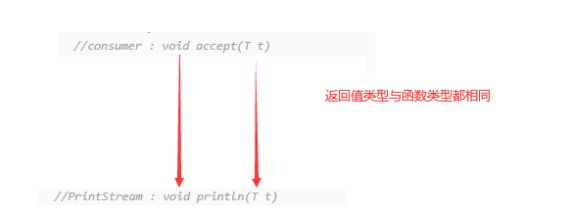JAVA8新特性-方法引用与构造器引用
方法引用
1.使用情境:当要传递给Lambda体的操作,已经有实现的方法了,可以使用方法引用!
2.方法引用,本质上就是Lambda表达式,而Lambda表达式作为函数式接口的实例。所以方法引用,也是函数式接口的实例。
3. 使用格式: 类(或对象) :: 方法名
4. 具体分为如下的三种情况:
情况1 对象 :: 非静态方法
情况2 类 :: 静态方法
情况3 类 :: 非静态方法
5. 方法引用使用的要求:要求接口中的抽象方法的形参列表和返回值类型与方法引用的方法的形参列表和返回值类型相同!(针对于情况1和情况2)
--------------------------------------------------------------------------------------------------------
文字太抽象,直接上例子
case 1:对象 :: 非静态方法
//例一
@Test
public void test1(){
//initial
Consumer con=new Consumer() {
@Override
public void accept(String s) {
System.out.println(s);
}
};
//lambda
Consumer con1=s-> System.out.println(s);
con1.accept("love");
//Method References
//consumer : void accept(T t)
//PrintStream : void println(T t)
PrintStream ps = System.out;
Consumer con2=ps :: println;
con2.accept("peace");
Supplier supplier=()->new String("123");
System.out.println(supplier.get());
} //例二
//Supplier中的T get()
//Employee中的String getName()
@Test
public void test2() {
Employee emp = new Employee(1001,"Tom",23,5600);
Supplier sup1 = () -> emp.getName();
System.out.println(sup1.get());
System.out.println("*******************");
Supplier sup2 = emp::getName;
System.out.println(sup2.get());
} case 2:类 :: 静态方法
//Comparator中的int compare(T t1,T t2)
//Integer中的int compare(T t1,T t2)
@Test
public void test3() {
Comparator com1 = (t1,t2) -> Integer.compare(t1,t2);
System.out.println(com1.compare(12,21));
System.out.println("*******************");
Comparator com2 = Integer::compare;
System.out.println(com2.compare(12,3));
}
//Function中的R apply(T t)
//Math中的Long round(Double d)
@Test
public void test4() {
Function func = new Function() {
@Override
public Long apply(Double d) {
return Math.round(d);
}
};
System.out.println("*******************");
Function func1 = d -> Math.round(d);
System.out.println(func1.apply(12.3));
System.out.println("*******************");
Function func2 = Math::round;
System.out.println(func2.apply(12.6));
}
case 3:类 :: 实例方法 (有难度)
细分为两个情况
Ⅰ: Comparator中的int comapre(T t1,T t2) -tip:上下的t1是同一个t1,t2是同一个t2
String中的 int t1.compareTo(t2)
函数式接口的抽象方法中有两个参数t1和t2,而执行语句是调用t1的方法,且将t2作为参数
Ⅱ: Function中的 R apply(T t)
Employee中的 String t.getName();
函数式接口的抽象方法中只有一个参数t,而执行语句是调用t的方法(无参数)
// 情况三:类 :: 实例方法 (有难度)
// Comparator中的int comapre(T t1,T t2)
// String中的int t1.compareTo(t2)
@Test
public void test5() {
Comparator com1 = (s1,s2) -> s1.compareTo(s2);
System.out.println(com1.compare("abc","abd"));
System.out.println("*******************");
Comparator com2 = String :: compareTo;
System.out.println(com2.compare("abd","abm"));
}
//BiPredicate中的boolean test(T t1, T t2);
//String中的boolean t1.equals(t2)
@Test
public void test6() {
BiPredicate pre1 = (s1,s2) -> s1.equals(s2);
System.out.println(pre1.test("abc","abc"));
System.out.println("*******************");
BiPredicate pre2 = String :: equals;
System.out.println(pre2.test("abc","abd"));
}
// Function中的R apply(T t)
// Employee中的String getName();
@Test
public void test7() {
Employee employee = new Employee(1001, "Jerry", 23, 6000);
Function func1 = e -> e.getName();
System.out.println(func1.apply(employee));
System.out.println("*******************");
Function func2 = Employee::getName;
System.out.println(func2.apply(employee));
} 
